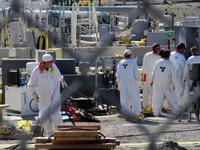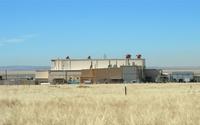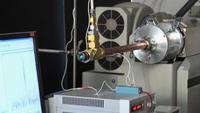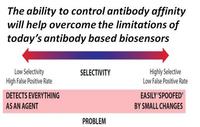-
June workshop on approaches to CBRNE incidents
NIST-organized workshop will explore ways to improve an all-of-government approach that increases resilience to international chemical, biological, radiological, nuclear, or explosive (CBRNE) incidents.
-
-
U.S. nuclear industry resists stricter, post-Fukushima safety measures
Since the March 2011 Fukushima disaster, members of the Nuclear Regulatory Commission (NRC) have been debating whether or not to impose even stricter safety measures on the thirty-one U.S. boiling water reactors (BWRs). Utility companies have been fighting any new safety regulations, arguing that the security measures they have are more than enough.
-
-
Arsenic in groundwater in Bangladesh naturally occurring
Human activities are not the primary cause of arsenic found in groundwater in Bangladesh. Instead, a team of researchers found that the arsenic in groundwater in the region is part of a natural process that predates any recent human activity, such as intensive pumping.
-
-
Audits find “troubling” security flaws in CDC labs
Laboratories at the Centers for Disease Control Prevention (CDC) have been cited in government audits for failing to secure bioterror agents such as anthrax and plague. The audits also found that employees handling these agents have not been trained properly to do so.
-
-
DHS awards contract for utility plant at the Kansas biolab
DHS has awarded a $40 million contract to build a utility plant at a $1.15 billion animal research lab in Kansas. The 87,000 square foot facility will replace an animal research lab on Plum Island in New York and will be used to research deadly animal diseases that affect livestock.
-
-
Radioactive leaks at Washington’s Hanford nuclear reservation

Earlier this month, Washington Governor Jay Inslee announced that a radioactive waste tank at one of the nation’s most contaminated nuclear sites is leaking, bringing more bad news to Washington’s Hanford nuclear reservation. The 177 tanks at the plant, which hold millions of gallons of highly radioactive waste from plutonium production, are way past their intended 20-year life span.
-
-
Sandia Labs refurbishes nuclear security infrastructure

Sandia National Laboratories has completed $199 million in facilities construction and repair as part of an 11-year national effort to revitalize the physical infrastructure of nuclear security enterprise sites. The work is part of a program established in 2001 to reduce a long-standing backlog of deferred maintenance at the National Nuclear Security Administration’s (NNSA) eight sites, including Sandia.
-
-
New explosives vapor detection technology

Novel explosives detection method focuses on direct, real-time vapor detection rather than collection of explosives particles. It could change paradigm for explosives screening.
-
-
Defusing the threat of ionizing radiation
The damage to Japan’s Fukushima nuclear reactor after the 2011 Tohoku earthquake raised concerns regarding U.S. preparedness to treat large-scale human exposure to ionizing radiation. Additionally, the immediate destructive potential of nuclear and radiological weapons, as well as their long-term health and economic impacts, continue to be of concern to DoD. Researchers look for novel approaches to mitigate immediate and long-term health damage from acute exposure to ionizing radiation and model its biophysical effects.
-
-
Improving detection of, responses to biological warfare

Biological warfare agents pose more than a hypothetical threat to U.S. soldiers. Troops operate in hostile areas where they could come under attack from adversaries wielding bio-agents like anthrax and toxins. The first step in reacting to any such attack is knowing that it occurred. Quickly and accurately identifying the presence of airborne antigens can be difficult given their complexity, the presence of numerous similar microorganisms in the environment, and the fact that even minute quantities of a threat agent can cause infection. Researches seek to advance sensitivity and durability of antibody-based biosensors better to protect soldiers.
-
-
Keeping an eye on the world’s dangerous chemicals
In the chemistry labs of the developing world, it is not uncommon to find containers, forgotten on shelves, with only vague clues to their origins. The label, if there is one, is rubbed away. Left alone for years, some chemicals can quietly break down into explosive elixirs, and what was once an innocent experiment by a well-meaning scientist becomes a very real, unsecured threat. Should such chemicals fall into malicious hands, the consequences could be widespread and deadly.
-
-
Idaho debating nuclear waste storage
For two decades, the Yucca mountain nuclear waste repository in Nevada was viewed as a long-term solution to the growing problem of radioactive waste generated by the 104 active nuclear power generation plants in the United States. One of the Obama administration’s first acts was to “defund” the project, in effect outing an end to it. States such as Texas, New Mexico, and North Carolina have fashioned their own interim solution to the problem of nuclear waste storage, and the governor of Idaho wants his state to follow these states’ example.
-
-
Promising substance for better cyanide antidote for terrorist attacks
In an advance toward closing a major gap in defenses against terrorist attacks and other mass casualty events, scientists are reporting discovery of a promising substance that could be the basis for development of a better antidote for cyanide poisoning.
-
-
Increasing the sensitivity of airport security screening
The latest episode in the American Chemical Society’s (ACS) Global Challenges/Chemistry Solutions podcast series reports a simple way to improve the sensitivity of the test often used to detect traces of explosives on the hands, carry-ons, and other possessions of passengers at airport security screening stations.
-
-
Part Three: Bechtel and the Y-12 security breach
With an annual security budget of $150 million, the Y-12 Nuclear Complex at Oakridge, Tennessee, prided itself on its high-tech security system built to protect more than 179 tons of uranium. After Sister Megan Rice, age 82, and two confederates, both senior citizens, too — the three were armed with nothing but wire cutters and flashlights — broke into the Y-12 facility on 28 July 2012, one security guard was fired. Numerous investigations and reports, however, show that last July’s incident was but one in a series of security failures and breaches at nuclear sites under the supervision of the National Nuclear Security Administration (NNSA). In May, Sister Rice and her aging collaborators will stand trial. Bechtel, a major contractor sharing responsibility for the documented security lapses at Y-12, has just received a federal nuclear plant security contract worth more than $22 billion.
-
More headlines
The long view
Keeping the Lights on with Nuclear Waste: Radiochemistry Transforms Nuclear Waste into Strategic Materials
How UNLV radiochemistry is pioneering the future of energy in the Southwest by salvaging strategic materials from nuclear dumps –and making it safe.
Model Predicts Long-Term Effects of Nuclear Waste on Underground Disposal Systems
The simulations matched results from an underground lab experiment in Switzerland, suggesting modeling could be used to validate the safety of nuclear disposal sites.
